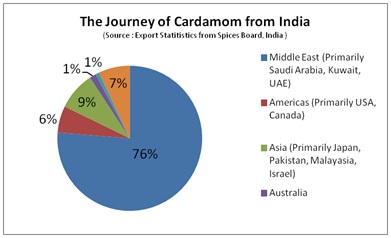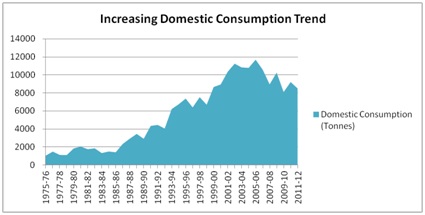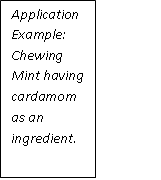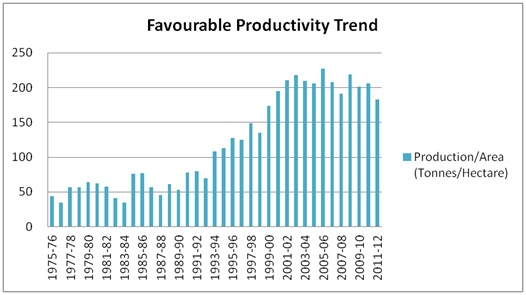Cardamom, the ‘queen of spices’, with its exotic flavor and aroma is the world’s third most expensive spice by weight, outstripped in market value only by Saffron and Vanilla. Its warm sweet penetrating aroma of complex flavors, adds that ‘extra’ pinch of mystery to this ancient spice. Ancient Greek, Roman, Egyptian and Arab cultures were equally found of the spice.
They thrive in the freshness and breathtaking beauty of the tropical rainforests. There are two major origins for Cardamom cultivation today: Guatemala in Central America and Southern India (in the order of annual crop quantity). Guatemala, the market leader has a big advantage in export markets because its climate allows for production all the year round, compared to being at the whims and fantasies of the monsoon in India.
India was once the world export leader with an estimated 56 percent of the global market in 1970. India’s share of the world market has declined due to:
1. High production cost: Cardamom is a highly labor intensive crop and account for 60-70% of the total production cost. The trick is in the picking. Labor shortage is a problem Indian agriculture has been grappling with.
2. Low yields and decreasing volatile oil (VO) content: The flavor and aroma profile of Cardamom are characteristic of the volatile oil content in it. The challenge here is to increase total VO content, without increasing the concentration of 1, 8-Cineol – too much of which alters the flavor profile, unfavorably.
3. Pesticide Residues: High pesticide use in conventional farming, make the crop unfit for export, because they cannot meet the stringent regulatory norms set by importing countries.
4. Exportable surplus: India exports 35% of its production today, compared to around 70% in the 1970s – The percentage exported v/s what is consumed has been going down. Considering the high domestic consumption rate which has been increasing over the years, the creation of exportable surplus in the coming years, would become a challenge.
![]()

The picture is not all that bad – because beyond the obstacles, ‘opportunity’ beckons in different forms 1. The increasing demand for Cardamom :
1. The increasing demand for Cardamom :
a. Saudi Arabia is the world’s largest importer of Cardamom. A concoction made of Coffee and Cardamom is a popular drink in the Middle East.
c. Domestic consumption has been steadily on the rise and India continues to be the largest consumer market for Cardamom. It features heavily in curries, pickles, and spice blends (e.g. Garam Masala) in India.
 d. Popular functional health benefits : Cardamom was used extensively in traditional Chinese and Indian Medicine, for our 3000 years, especially for pulmonary disease, fever, digestive and urinary complications. Hippocrates recommended it for sciatica, coughs, abdominal pains, spasms, nervous disorders, retention of urine and also for bites of venomous creatures.
d. Popular functional health benefits : Cardamom was used extensively in traditional Chinese and Indian Medicine, for our 3000 years, especially for pulmonary disease, fever, digestive and urinary complications. Hippocrates recommended it for sciatica, coughs, abdominal pains, spasms, nervous disorders, retention of urine and also for bites of venomous creatures.
Ancient claims are today sanctioned by science and used by Global companies looking for exotic cures to differentiate their products.
2. Moving up the value chain: Cardamom is also used in processed food and cosmetics, as flavors and fragrances, in the form of extracts, oleoresins and essential oils – through steam distillation and solvent extraction of the dried ripe fruit. The principal constituents include Terpinyl acetate and cineol, limonene, sabiene, linalol, linalyl acetate, pinene, zingiberene, among others.
These extracts are used in Bakery (cakes, cookies), Dessert, Confectionary (Candy, Chewing gum) and Personal Care (Tooth paste, fragrances) applications.


1.Changing tastes and preferences: The western world due to its geographical proximity to Guatemala has grown accustomed to the flavor profile characteristic of Cardamom from that origin. Crop failures at Guatemala, have had multinational companies like the Wrigley’s looking out for alternate origins. They have played a part in shifting global consumer tastes and preference to accept the flavor nuances of the Indian Cardamom.
2. Higher Productivity

This was partly, as a result of the spread of a new variant of the indigenous Indian Cardamom. The variant is popularly called Najjani. This is a classic example of scientific interventions that saved the day.
The demand for cardamom will continue to rise, to meet the demands of a growing population and number of proven health and functional benefits with research. The question that the industry then faces is to make sufficient quantity available at the right quality. We should not let us concern constrain growth.
A steady supply of food safe spices of the desired quality would be a key factor of growth and we have to invest in technologies to ensure this. Five years back nobody wanted to put any money to integrate backwards – to make a food safe supply chain – today the need in the industry is well felt. Companies in Kerala engage in what they call IPM (Integrated Pest Management) programs to tightly control agricultural inputs, farm practices and thereby producing the quality they desire. There is a buy back arrangement entered into, and often the farmer obtains a premium.
For those things that cannot be accomplished by an individual company, associations such as the World Spice Organisation come into picture. WSO, has been working with farmers, scientists, processors, regulators and consumers, on projects that target different challenges: Awareness programs, joint discussions among different stakeholders to create a ‘coalition of the willing’ to work towards a sustainable future for cardamom.
Efforts are on to engage the academia, so that research has to take place and more importantly, advances in the lab have to reach the farm – to develop high yielding, high volatile content (without affecting productivity and increasing 1,8-cineole content) and pest resistant Cardamom.
